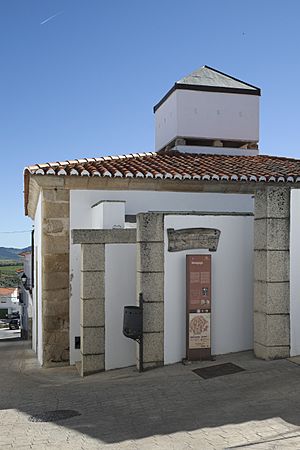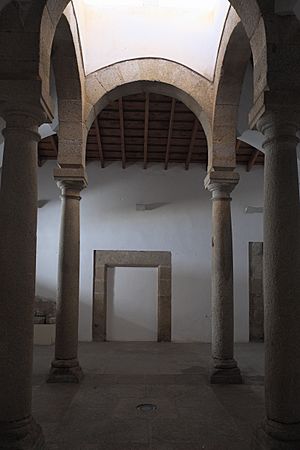Valencia de Alcántara Synagogue facts for kids
The Valencia de Alcántara Synagogue (Spanish: Sinagoga de Valencia de Alcántara) is an old building in Valencia de Alcántara, Spain. It used to be a synagogue, which is a Jewish place of worship. Today, it is no longer used as a synagogue.
Experts Carmen Balesteros and Jorge Oliveira believe this building was a synagogue. They found clues like its age, from the late 1400s. At that time, many Jewish people moved close to the Portuguese border. This was because they faced more difficulties in Castile, a part of Spain. The building also looks very similar to the Synagogue of Tomar in Portugal. After Jewish people were asked to leave Spain in 1492, the building was used for different things. For a long time, it was mainly a place to prepare meat.
Contents
Where It Is and How It Looks
The building is in what used to be the Jewish quarter during the Middle Ages. This area has nineteen streets with a Gothic style. It has been a protected historical site since 1997.
Building Design
The synagogue is shaped like a square, about ten meters by ten meters. Its walls are made of stone covered in white plaster. The roof is shaped like a pyramid, sloping down in four directions. There is one main entrance on the west side. This door leads into the main prayer room.
Inside, you will see four strong granite columns. These columns have simple, round bases and tops. Four rounded arches connect the columns. These arches help hold up the roof and its wooden beams. This design is very much like the Synagogue of Tomar in Portugal, built around the same time.
Special Wall Features
Historians Carmen Balesteros and Jorge Oliveira say there were once two other doors. These doors are now blocked by new buildings. They used to lead to a side room and a special prayer area for women.
On the wall opposite the main entrance, there is a part of the wall that has no plaster. It looks like a bare patch. According to the same experts, this bare spot is a way to remember something important. It honors the Destruction of the Second Temple in Jerusalem. This temple was destroyed by the Roman emperor Titus in the year 70 AD.
History of the Building
Clues like old metal pieces and a Portuguese coin from the 1200s suggest the building was first a forge. A forge is a place where metal is heated and shaped. Another Portuguese coin, from the mid-1400s, was found in the columns' foundations. This coin suggests the building became a synagogue around that time.
Jewish people in the Crown of Castile faced harder times. So, living near the border with Portugal was a good idea. It meant they could escape if they needed to. But the building was only used as a synagogue for a short time. In 1492, the Alhambra Decree was issued. This order made all Jewish people leave Spain.
Later Uses
The old synagogue was purposely burned in the 1500s or 1600s. Animal bones found there show it was then used as a place to prepare meat. This continued until the 1900s. After that, it became a garage, a tavern, and even a place to store coal. When it was a meat preparation area, it likely helped make the famous local ham, Jamón ibérico.
In the 1990s and early 2000s, Carmen Balesteros and Jorge Oliveira said the building was a synagogue. This idea was debated by other experts. This is because they only had physical clues, not old papers, to prove it was a synagogue.
See also
 In Spanish: Sinagoga de Valencia de Alcántara para niños
In Spanish: Sinagoga de Valencia de Alcántara para niños



